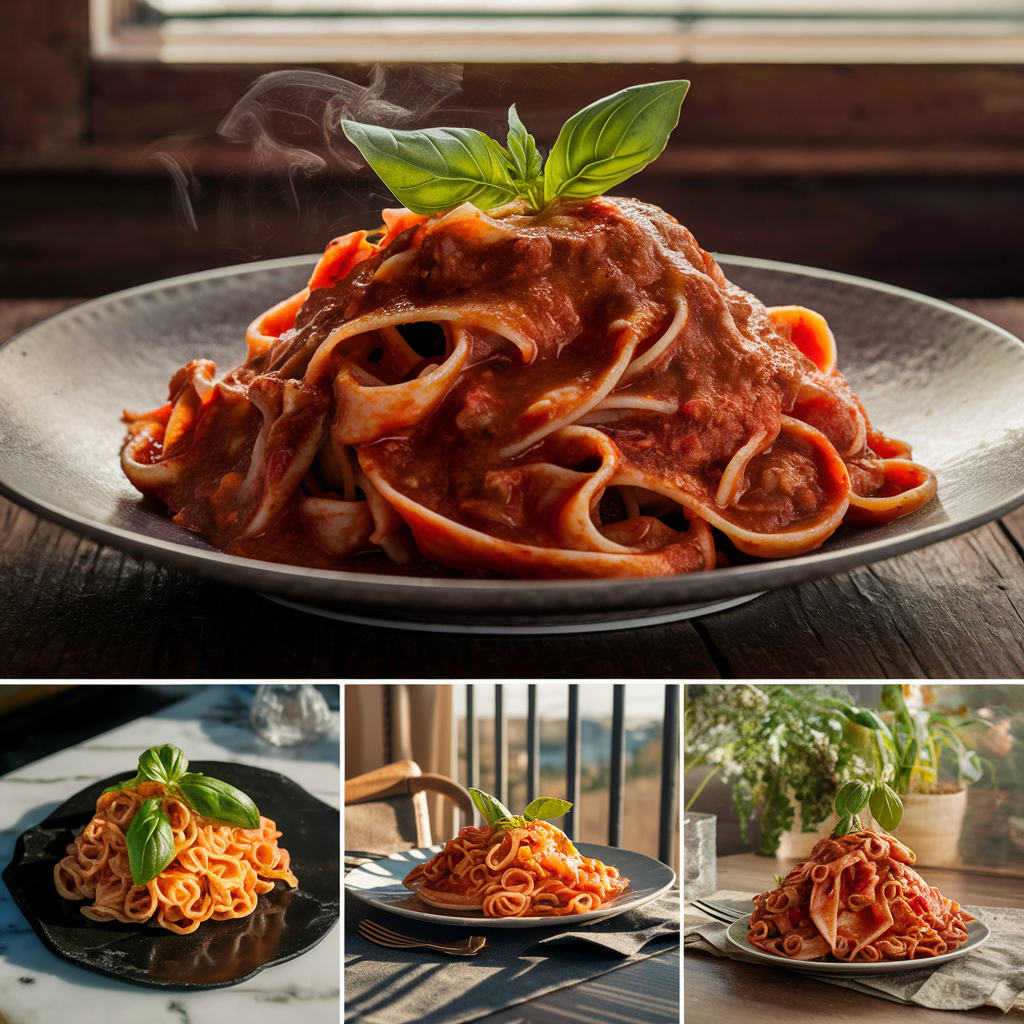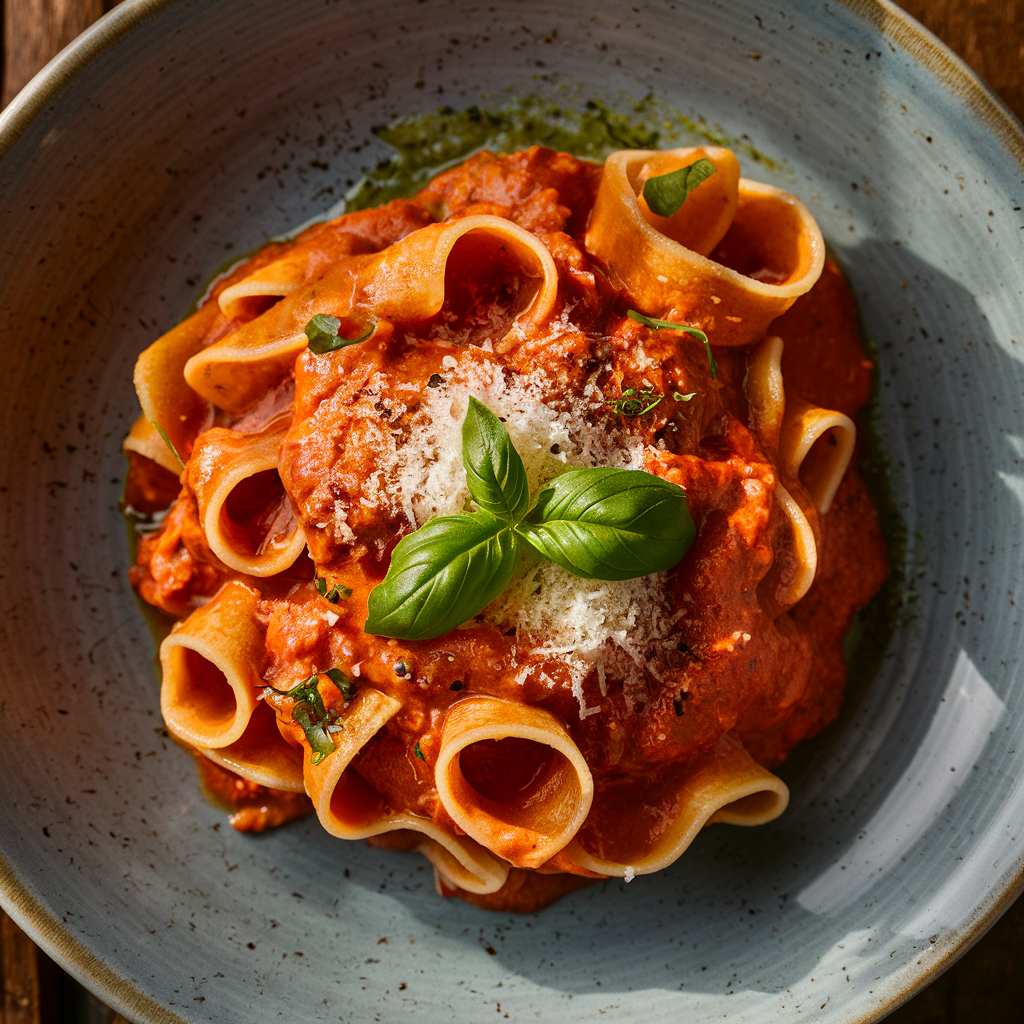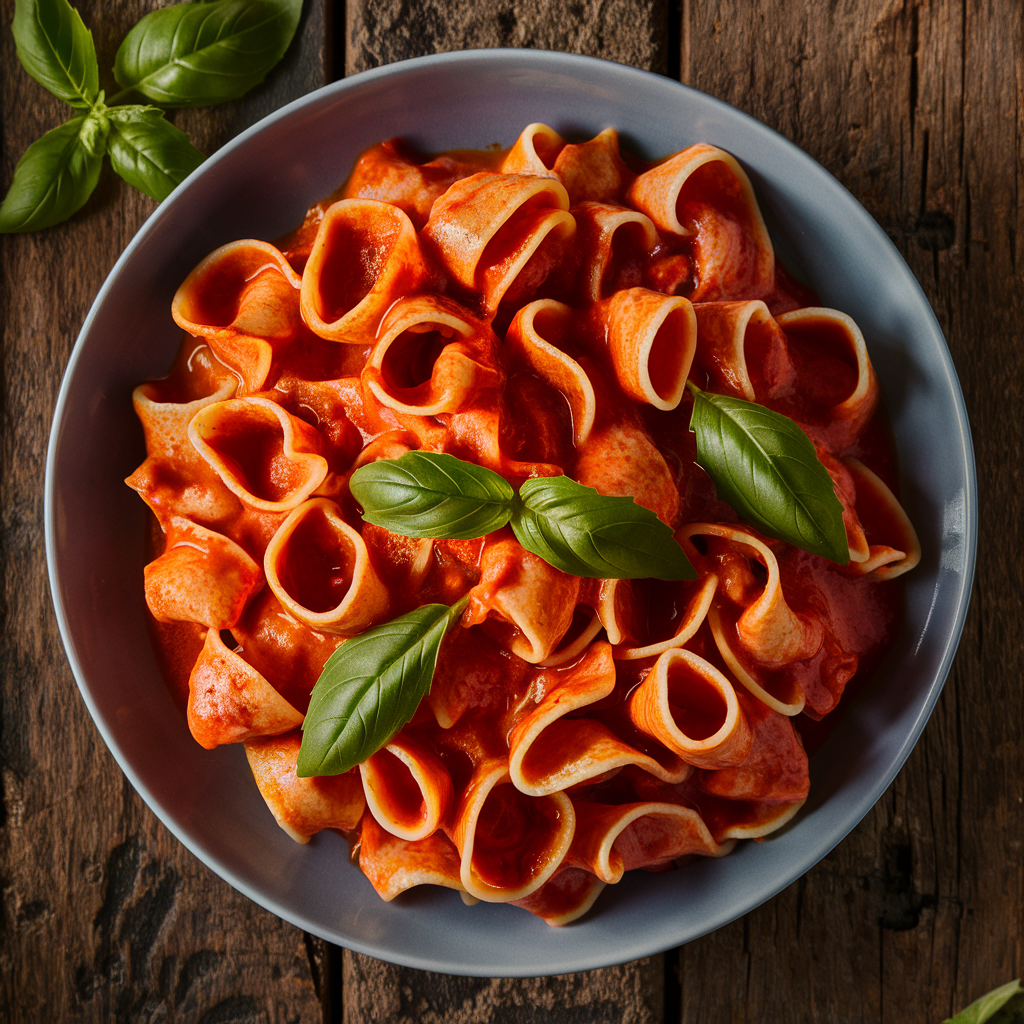Table of Contents
Introduction to Campanelle
Campanelle is a fascinating pasta shape that has garnered attention for its striking resemblance to bellflowers or small cones. This unique silhouette is not only visually appealing but also serves a functional purpose in culinary applications. The design of campanelle, characterized by its flared edges and crevices, allows it to capture and embrace a variety of sauces, making it a remarkable choice for those seeking a pasta that enhances the overall dish.
The texture of campanelle plays a significant role in its popularity. Its ridged surface provides an ideal texture for holding onto sauces, whether they be creamy, oily, or tomato-based. Unlike smoother pasta types, which may struggle to cling to sauces, campanelle excels at retaining flavors, creating a harmonious balance in every bite. This characteristic not only elevates the dish but also allows cooks to experiment with diverse combinations of ingredients.
When comparing it to other pasta shapes like fusilli and conchiglie, one can appreciate the distinct advantages that campanelle offers. Fusilli, with its spiral shape, and conchiglie, or shell pasta, both provide unique methods of sauce retention, yet they do not match the aesthetic presentation that campanelle brings to the table. While fusilli is excellent for tossing with thick sauces and conchiglie is perfect for containing small morsels, campanelle’s cone-like structure makes it particularly well-suited for baked dishes and salads, where it can shine both in texture and appearance.
This pasta is a favored choice not only for its ability to hold sauces but also for its versatility. Campanelle can be used in a range of culinary preparations, from traditional Italian recipes to innovative contemporary dishes, showcasing its adaptability and appeal to a wide audience of pasta enthusiasts.
Origin and History
Campanelle, a unique pasta shaped like small bells or flower petals, traces its origins back to the southern regions of Italy, specifically in areas renowned for their culinary traditions such as Campania and Calabria. This artisanal pasta is believed to have been created in the 18th century as a part of the evolving Italian gastronomic landscape. its name, derived from the Italian word for bell, aptly reflects its charming shape and aesthetic appeal, making it a favorite in various Italian dishes.
The history of campanelle is deeply intertwined with the agricultural practices and local ingredients of southern Italy. Traditionally, the pasta was made from durum wheat semolina, which is known for its firmness and ability to hold sauces well. In the past, families would often prepare fresh pasta at home, and it became a staple at family gatherings and special occasions, serving as a focal point in hearty regional meals.
In recent years, interest in diverse pasta shapes has surged, with chefs and home cooks alike embracing campanelle for its unique texture and visual appeal. Today, it proudly occupies a place in both casual and gourmet dining settings, reaffirming its significance in Italian culinary history. The revival of traditional pasta-making methods, coupled with modern culinary innovation, ensures that the story of campanelle continues to evolve, delighting palates around the world.
Culinary Applications of Campanelle Pasta
Campanelle pasta, with its unique shape resembling small bellflowers, has gained popularity for its versatility in various culinary applications. This distinctive form not only adds visual appeal to dishes but also holds sauce exceptionally well, making it an ideal choice for a range of recipes. One of the classic pairings for campanelle is creamy sauces, such as Alfredo or carbonara.

The pasta captures the sauce in its frilly edges, ensuring each bite is rich and satisfying. Chefs often use campanelle in risottos where the pasta is combined with creamy and savory ingredients, allowing the flavors to meld beautifully.
In addition to creamy preparations, campanelle naturally complements hearty meat ragùs. The sturdy shape of this pasta enables it to hold up against robust sauces made with ground meats, tomatoes, and aromatic herbs, creating a nourishing and hearty meal. Traditional Italian dishes like baked pasta can also benefit from campanelle. When layered with ricotta, mozzarella, and marinara, the pasta retains its structure and provides a delightful texture contrast.
Furthermore, campanelle is adaptable in contemporary cuisine, often incorporated into innovative dishes that highlight seasonal vegetables. Fresh vegetable-based sauces, such as pesto or a light tomato dressing, showcase the pasta’s ability to enhance vibrant flavors. Chefs appreciate it not only for its aesthetic appeal but also for its ability to harmonize with diverse ingredients, making it a popular choice in both professional kitchens and home cooking environments. With its myriad of culinary applications, campanelle continues to inspire creativity in the kitchen, appealing to those who relish both traditional Italian fare and modern interpretations.
Cooking Tips for Campanelle
Cooking campanelle to achieve the perfect al dente texture requires attention to detail and some fundamental practices. To start, select high-quality dried campanelle pasta, as this will significantly affect the final dish. The cooking process begins with bringing a large pot of salted water to a vigorous boil. A general rule of thumb is to use around one tablespoon of salt for every four quarts of water. Adding salt enhances the pasta’s flavor during cooking and is crucial for achieving a savory taste.
Once the water reaches a rolling boil, add the campanelle and stir gently to prevent the pasta from sticking together. The cooking time typically ranges from 8 to 12 minutes, depending on the brand and thickness of the pasta. It is advisable to refer to the package instructions for specific timing recommendations. To ensure the pasta remains al dente—firm to the bite—taste the campanelle a minute or two before the suggested cooking time is over. This careful monitoring will help you find the ideal texture.
After the campanelle is cooked to your preference, reserve some of the pasta water before draining it. This starchy water can be useful for adjusting the consistency of sauces later on. For integrating it into various dishes, consider tossing it with a light olive oil dressing, a selection of fresh vegetables, or a rich tomato sauce. The pasta’s unique shape makes it excellent for holding onto sauces, allowing for a flavorful experience with each bite. Additionally, experimenting with different herb seasonings or cheese can elevate the dish further, showcasing the versatility of campanelle.
Nutritional Information
Campanelle pasta is a distinctive shape that not only adds visual appeal to a dish but also offers specific nutritional benefits. Generally, a serving size of cooked campanelle, approximately 1 cup, contains around 200 calories. This calorie count can vary based on preparation methods and additional ingredients used, such as sauces or proteins. It is predominantly composed of carbohydrates, which play a crucial role as a primary source of energy. A typical serving contains about 40 grams of carbohydrates, making it an excellent choice for individuals seeking to fuel their daily activities or workouts.
In addition to carbohydrates, campanelle pasta offers a modest amount of protein, averaging about 7 grams per serving. While this protein level may not be sufficient on its own, it can significantly contribute to the overall protein intake when combined with other ingredients, such as vegetables, meats, or legumes. This combination can promote a more balanced diet by providing essential amino acids necessary for bodily functions.
Moreover, campanelle pasta is typically made from durum wheat semolina, which contains several nutrients. It offers vitamins such as B vitamins, particularly thiamine and folate, that are important for energy metabolism and cell function. There are considerations for those keeping a close watch on their carbohydrate intake, particularly individuals managing diabetes or following a low-carb diet. In such cases, portion control or alternatives like whole grain or legume-based pasta can be explored without compromising the delightful experience of enjoying pasta. By understanding the nutritional profile of campanelle, consumers can make informed dietary choices that align with their health goals while savoring this unique pasta variety.
Pairing Wines with Campanelle
When it comes to enjoying campanelle, an Italian pasta known for its unique shape and texture, the right wine can significantly enhance the overall dining experience. The delicate, yet robust character of campanelle allows for an array of sauces and ingredients, which in turn influences wine selection. Understanding the nuances of both pasta and wine can lead to a delightful culinary experience.
For campanelle served with lighter sauces, such as a lemon-garlic olive oil or a fresh tomato basil sauce, white wines are an excellent choice. A crisp Pinot Grigio, with its refreshing acidity and fruity undertones, complements the flavors of the dish without overpowering them. Similarly, a Sauvignon Blanc, known for its herbal notes and citrus zest, can elevate the fresh ingredients in the sauce, enhancing the overall taste of the meal.
If you prefer a heartier dish, such as campanelle with a rich cream or cheese sauce, a fuller-bodied white wine, such as Chardonnay, provides a perfect match. The creaminess of the wine complements the texture of the sauce, while its toasty notes can enhance the flavor profile of the dish.
For those inclined towards red wines, campanelle paired with robust sauces such as a Bolognese or a ragu can benefit from a medium-bodied Chianti. This wine’s acidity cuts through the richness of the sauce while bringing out the savory elements of the dish. Alternatively, a Barbera, known for its fruity profile and low tannins, can also harmonize beautifully with tomato-based sauces, providing a balance that highlights the flavors without overwhelming the palate.
Ultimately, the key lies in obtaining a harmonious balance between the flavors of the campanelle dish and the chosen wine. By considering the sauce and accompanying ingredients, you can select the ideal wine pairing that enhances your dining experience.
Vegetarian and Vegan Recipes
Campanelle, with its unique shape reminiscent of a bellflower, serves as an excellent base for a variety of vegetarian and vegan dishes. Its ability to hold sauces and ingredients makes it particularly versatile in plant-based culinary applications. One particularly enticing recipe is Campanelle Primavera, where the pasta is paired with an array of seasonal vegetables. Simply sauté bell peppers, zucchini, and asparagus in olive oil, infuse with garlic, and toss with cooked campanelle. For an added burst of flavor, a sprinkle of nutritional yeast can replicate the richness of cheese, making it a delightful choice for vegans.
Another exceptional recipe is a Campanelle with Spinach and Cherry Tomatoes. By lightly cooking the spinach and halved cherry tomatoes in a pan, you can create a vibrant and nutritious dish. Mix in the cooked campanelle, drizzle with balsamic glaze, and finish with a handful of fresh basil for a simple yet satisfying meal. This combination not only showcases the pasta’s ability to blend seamlessly with vegetables but also highlights an array of colors and flavors that excite the palate.
For a heartier option, consider it with Creamy Avocado Sauce. By blending ripe avocados with garlic, lemon juice, and fresh herbs, you create a luscious vegan sauce that clings beautifully to the pasta. Incorporate peas or spinach for added texture and nutrition. This dish offers a creamy alternative without dairy, making it a perfect addition to your repertoire of plant-based recipes.
The adaptability of campanelle shines through in these recipes, allowing it to complement various ingredients while appealing to those with vegetarian and vegan dietary preferences. Embrace the opportunity to experiment with this unique pasta, tailoring dishes to your taste while enjoying its delightful form and texture.
Gourmet Campanelle: Elevating Your Dish
Campanelle, with its distinctive curled shape and ridges, presents numerous opportunities to transform a simple meal into a gourmet experience. To elevate your campanelle dishes, consider incorporating high-quality ingredients that not only enhance the taste but also add visual appeal. Opt for artisanal pasta made from premium durum wheat, as the quality of the pasta is crucial in determining the overall dish’s success. This investment in ingredients can make a noticeable difference in texture and flavor, allowing the dish to truly shine.
Garnishing is another essential aspect to consider when attempting to create a gourmet campanelle dish. Fresh herbs such as basil, parsley, or chives can add vibrancy and a burst of flavor. Try experimenting with edible flowers to give your presentation an elegant touch. Creating a striking contrast with colorful ingredients, such as vibrant cherry tomatoes or visually appealing roasted vegetables, can make the dish more Instagram-worthy and appetizing for your guests.
Flavors and textures can be creatively combined to generate a more complex and satisfying culinary experience. Introducing gourmet elements like truffle oil or a sprinkle of aged Parmigiano-Reggiano can contribute rich umami notes to the overall flavor profile. Consider also incorporating a variety of textures—such as a creamy sauce paired with crispy pancetta or toasted pine nuts—to stimulate the palate and enhance the enjoyment of the dish. Moreover, fresh seasonal ingredients not only enrich the flavor but also emphasize sustainability and the bounty of local farms, making your gourmet campanelle dishes both delectable and responsible.
By focusing on these aspects—quality ingredients, meticulous garnishing, and thoughtful flavor combinations—you can elevate your campanelle recipes into gourmet creations that will impress guests and elevate your family meals to new heights. Embrace creativity and boldly experiment with each ingredient to craft truly memorable dishes centered around this unique pasta.

Conclusion
In summary, Campanelle pasta stands out for its unique shape and delightful texture, making it a versatile choice for various culinary creations. Its fluted, bell-like design allows sauces to cling beautifully, enriching every bite with flavor. This pasta variety not only enhances the aesthetic appeal of a dish but also elevates the overall dining experience. Whether you opt for a traditional Italian recipe or choose to incorporate it into contemporary dishes, its adaptability shines through.
Moreover, the unique characteristics of Campanelle allow it to pair well with an array of ingredients, from fresh vegetables and delicate seafood to rich meats and hearty cheeses. The pasta’s ability to hold sauces gives it an edge in creating dishes that are both satisfying and flavorful. By experimenting with various recipes, including those we shared, one can discover just how delightful Campanelle can be in different culinary contexts.
Furthermore, incorporating Campanelle into your meal planning is not just about trying a new pasta; it’s about embracing a food that offers robust flavor dimensions and textural experiences. From a warm, comforting casserole to an elegant pasta salad, the options are plentiful and inviting. So, whether you are cooking for a family dinner or hosting a gathering, consider adding it to your table. It is a celebration of culinary creativity waiting to be explored, and its distinguished shape and flavor will surely leave a lasting impression on your guests.


4 thoughts on “Exploring Campanelle: The Amazing Pasta You’ll Love”
Comments are closed.